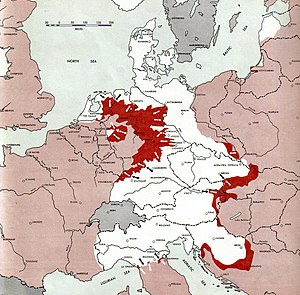| Syrmian Front | |||||||
|---|---|---|---|---|---|---|---|
| Part of the Yugoslav and Eastern fronts of the European theatre of World War II | |||||||
 Syrmian frontline (far south-east) as a part of the European Eastern Front in April 1945. | |||||||
| |||||||
| Belligerents | |||||||
|
Allies: (including Italia Brigade) |
Axis: | ||||||
| Commanders and leaders | |||||||
|
|
| ||||||
| Casualties and losses | |||||||
|
(including | Total 30,000 killed[2] | ||||||
The Syrmian Front (Serbo-Croatian: Srijemski front/Sremski front) was an Axis line of defense during World War II. It was established as part of the Eastern Front in late October 1944 in Syrmia and east Slavonia, northwest of Belgrade.
After the Yugoslav Partisans and the Red Army expelled the Germans from Belgrade in the Belgrade Offensive, the retreating Wehrmacht and the Croatian Armed Forces used fortifications to protect the withdrawal of German Army Group E from the Balkans. With help from their Soviet allies, the Partisans (by then recognized as the Yugoslav army), joined by Bulgarian and Italian forces, fought a difficult winter campaign and finally broke through the front on 12 April 1945.
After the Syrmian front was broken, occupied Yugoslavia was liberated.[3]
- ^ 62nd Anniversary announcement Archived 7 June 2011 at the Wayback Machine, B92, 2007.
- ^ a b Stratište srpske mladosti, Vlada Arsić, 2008. (in Serbian)
- ^ »Sremski front 1944–1945«, n. f. str. 42, 166, 200 i 285.